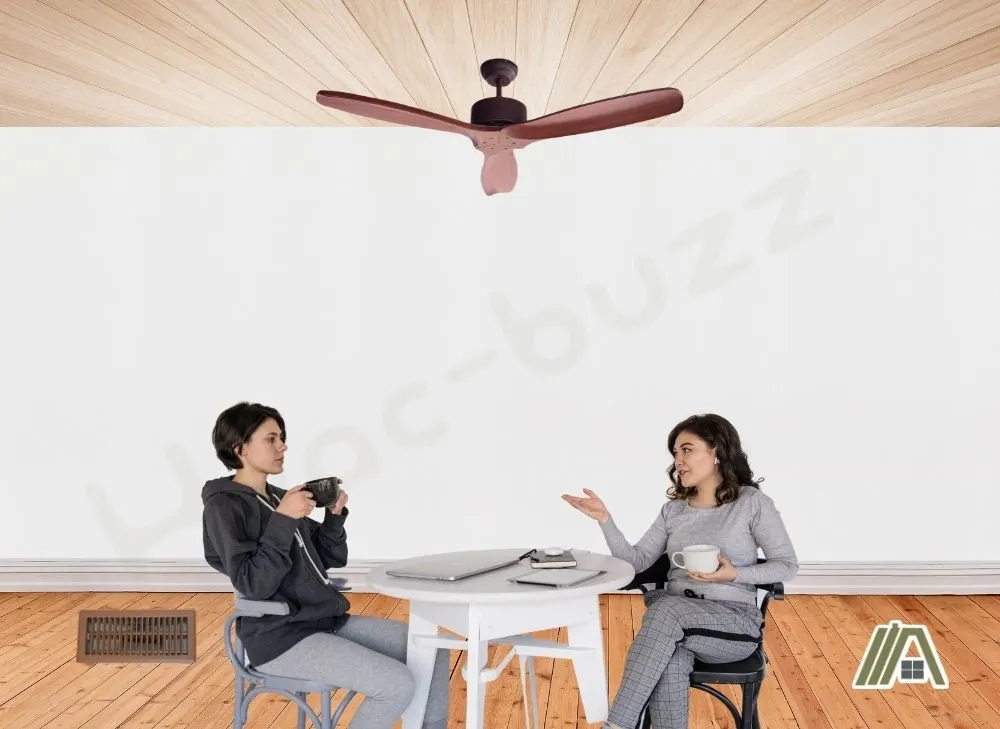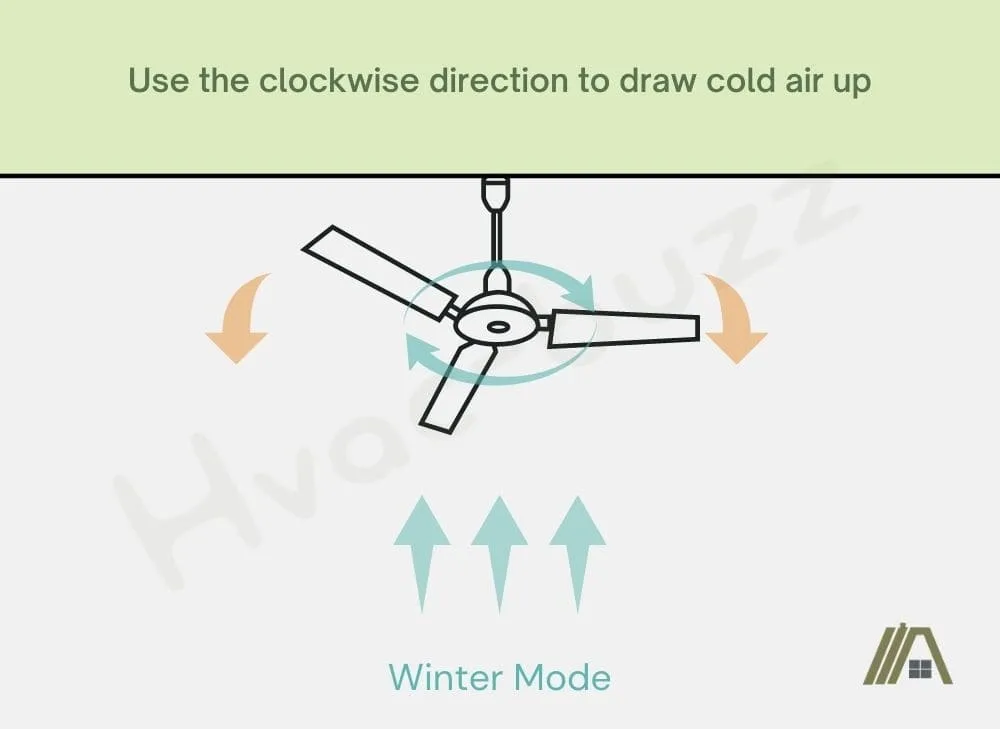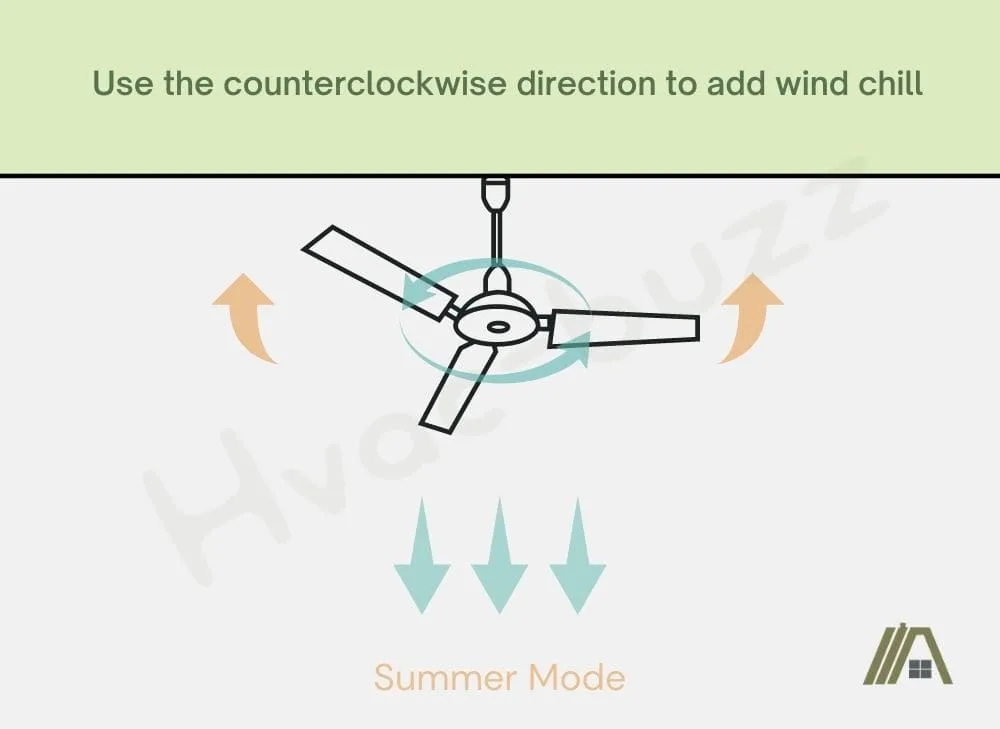Rather than turning up the intensity of your HVAC unit, you should consider just turning on a ceiling fan instead. Whether your goal is to heat or cool your home, a ceiling fan working together with your HVAC system can achieve a comfortable temperature in your home along with energy savings.
Simply turning on your ceiling fan will not automatically aid your HVAC system, however. If you have floor registers, ceiling fan rotation direction is important.

In winter, pair floor registers with clockwise ceiling fan rotation. In summer, clockwise rotation pulls the cold air up into the occupied space. In summer, counterclockwise direction introduces wind chill, and low speed and ceiling return vents help prevent cold air from being trapped against the floor.
Running the HVAC and Ceiling Fan Together
Although an HVAC system can sufficiently cool a house on its own, it can also be greatly aided by a ceiling fan.
Whether the goal is to heat, cool, or just keep a decent amount of airflow going in your house, a ceiling fan can do wonders.
Most ceiling fans can turn clockwise and counterclockwise, creating an air current that either pulls air up (clockwise) or pushes it down (counterclockwise).
In winter, ceiling fans help to pull cold air away from the occupied space of the room and push down the warm air that has gathered at the ceiling.
In doing so, the warmed air supplied by the HVAC system actually surrounds you and doesn’t just hug the ceiling. You are less likely to need to turn your thermostat up to try and heat up the air around you. This saves energy and money.

Summer mode on a ceiling fan pushes air down. As air flows over you, it triggers the wind effect. The layer of hot air trapped against your skin is blown away, allowing your body to cool down better. In this way, it makes you feel colder even in a room with a higher ambient temperature.
Once again, you would not have to set your thermostat to such an extreme temperature, allowing you to save on energy usage and expense.
Clockwise Direction in Winter
If your heated air is supplied via floor registers, then the goal of a ceiling fan running with your HVAC unit in the winter would be to aid this hot air to rise. Thankfully, heat naturally rises, but the process is fairly passive and not exactly fast.
Your ceiling fan set to clockwise is considered to be in winter mode. Rotating in this direction, a ceiling fan pulls air up from the room, thus aiding the rising hot air supplied through the floor registers.
The upward movement of air would also displace warm air that has risen to the ceiling and remains there because warm is less dense than cold air. This heater air would be re-distributed down towards the lower parts of the room around the occupants.
This is the best direction in winter regardless of where your return vents are. If you were to push the air down in counterclockwise rotation, then the warm air would be forced to stay at ground level, where it is ineffective.
Two Options in Summer
The direction of a ceiling fan in the summer with the use of an HVAC system is a bit more complicated than in the winter. Floor registers are not ideal in the summer because cold air sinks naturally and because ceiling fan cooling relies on the downward flow of air over occupants.
If you have floor registers supplying cold air, then you should ideally have ceiling return vents that can remove the naturally rising hot air.
To try and find the best way to deal with this less-than-ideal situation, you have two options, each with pros and cons.
1. Clockwise Direction to Draw Cold Air Up
The first option would be to use the clockwise direction to produce an upwards current. Because the cold air is supplied low down and it will stay here, cooling your feet, unless the ceiling fan intervenes, winter mode can actually be effective in summer.

But what about displacing all the hot air at the ceiling? Well, this only heats or helps to heat a room when there is an external source of heat, like a space heater or radiator. Otherwise, the difference in temperature between the air closest to the ceiling and the air further from it is not going to be that different.
In fact, if you are supplying cold air, you are lowering the overall ambient temperature, so the “warm” air rising to the ceiling is not necessarily what you would consider warm; it is only warmer than the cold air being supplied.
Unfortunately, because the fan is drawing air up, there won’t be a wind chill effect to provide a cooling sensation to the occupants.
2. Counterclockwise to Add Wind Chill
Summer mode or counterclockwise direction can also be effective; you will just have to assess which of the two options makes the most difference to you. Summer mode is most effective if the floor registers are countered with ceiling return vents.

The ceiling return vents draw rising warm air out. In doing so, it pulls cold air upward to eliminate the formation of a vacuum. Adding a ceiling fan rotating in a counterclockwise direction can impede this to a certain degree, although it is not likely to completely cancel out the effect.
In addition, if your ceiling fan is blowing air downwards, it produces a breeze that can flow over the room’s occupants, and they benefit from the cooling effect of wind chill and evaporative cooling (if you are sweating).
What would possibly be the best approach with counterclockwise rotation would be to set your ceiling fan to a slower speed. You still get the wind chill effect but the cold air doesn’t have to overcome as much force to rise into the occupied space.
